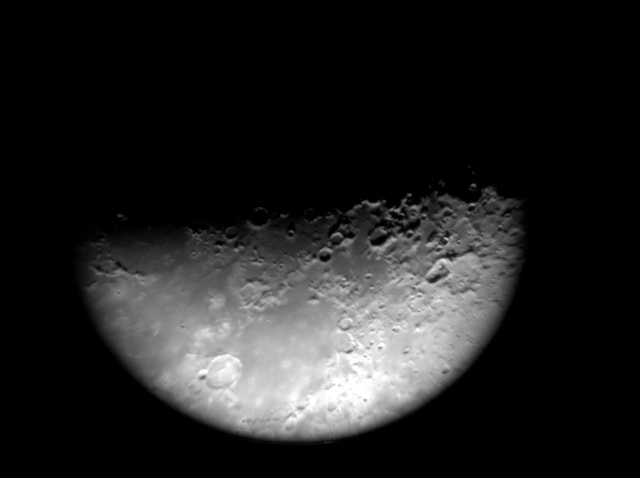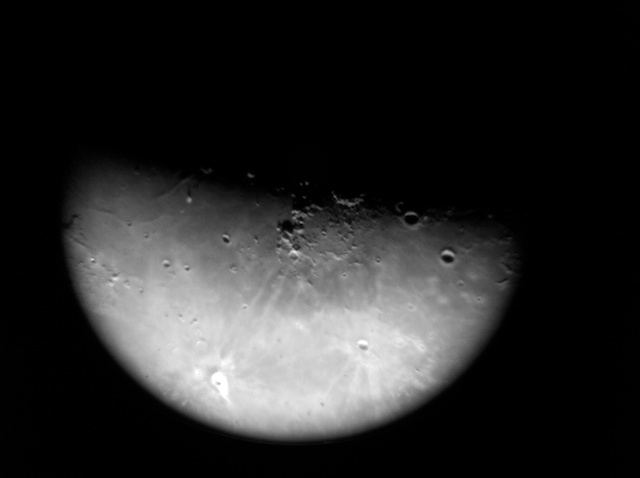
M51, NGC6822, NGC6723, NGC6726/7, IC4812, Moon
Last updated: 25 June 2011![[Home!]](http://www.weasner.com/etx/images/mighty_etx_logo_orig-sm.jpg)
 |
M51, NGC6822, NGC6723, NGC6726/7, IC4812, MoonLast updated: 25 June 2011 |
![[Home!]](http://www.weasner.com/etx/images/mighty_etx_logo_orig-sm.jpg) |
| Follow @mweasner | Welcome | Photos | Videos | Equipment | Links | Data |
Opened the observatory Friday, 24 June 2011, at 1900 MST, 104°F, for what ended up being a 7.5 hour session. The sky was clear but hazy. Shortly after opening the dome, I saw a quail family but they were too far away for good photographs. At 1917 MST, viewed Saturn at 77X and 133X. At 1934 MST, as the sun was setting, used 206X to view Saturn; planet and ring shadows were very nice. Cassini Division was obvious. At 1945 MST, switched back to 133X to start watching for moons to appear. 1952 MST: Titan. (At this point, I relocated the clock in the observatory to make it more viewable while at the eyepiece.) 1954 MST: Rhea. 1955 MST: Tethys, and then Dione. 2000 MST: Iapetus. At 2033 MST, I ended Saturn viewing.
I took a quick look at the fine double star Albireo at 2038 MST, and then began setting up for D7000 DSLR prime focus + Off-Axis Guider (OAG) imaging of M51, the Whirlpool Galaxy. SYNCed on M51 and used Dubhe for a focus test with the Bahtinov Mask. I then returned to M51 and began searching for a guide star. Finding none, I repositioned the OAG. I then located a good guide star and began imaging M51 at 2118 MST. This image is a cropped, guided, 5 minute, ISO 3200, exposure:

The supernova is still showing brightly.
Ended imaging at 2140 MST. Saw the first and only Kissing Bug of the night and it was terminated. SYNCed on Vega and did a tour of DSOs in Cygnus using the 26mm (77X) eyepiece. Viewed NGC6819 (Foxhead Cluster, open cluster), NGC6826 (planetary nebula), NGC6888 (Crescent Nebula), M29 (open cluster), NGC6960 (Veil Nebula), IC5067 (Pelican Nebula), NGC6992 (diffuse nebula), M39 (open cluster), and Caldwell 19 (diffuse nebula). I then slewed to one of the next imaging targets for the night: NGC6723 (globular cluster). Viewed it and the nearby NGC6726/7 and IC4812. They were currently too low for imaging so slewed to NGC6822 (Barnard's Galaxy). This is a very faint irregular galaxy and was difficult to see in the 26mm eyepiece. But it was high enough in the sky for imaging, so attached the D7000 at the 8" prime focus + OAG.
At 2254 MST, did a focus test on Altair with the Mask. Slewed to NGC6822 and began looking for a guide star. Had to reposition the OAG once and do a couple of framing test exposures to ensure I was capturing this faint galaxy. At 2306 MST, I began this 5 minute, ISO 6400, guided (slight cropped) exposure:

By now the globular cluster NGC6723 was high enough for imaging, and it was visible in the camera viewfinder. Took this unguided, 30 second, ISO 6400, exposure at 2317 MST:

I next added the focal reducer, focused on Antares with the Bahtinov Mask and slewed to NGC6723. I did some 1 minute framing test exposures and looked for a guide star. I then took this 5 minute, ISO 6400, guided, image of NGC6723 (left), NGC6726/7 (bottom right), and IC4812 (top right):

Faintly visible just to the right of NGC6726/7 is NGC6729.
Ended imaging at 0030 MST. Viewed M30 (globular cluster) at 77X. SYNCed on Altair and did a tour of DSOs in Aquila: NGC6709 (open cluster) and NGC6755 (open cluster). I then viewed M16 (Eagle Nebula near the meridian, and so at its highest point in the southern sky. It was a nice view in the 26mm eyepiece. I then noticed that M31, the Great Andromeda Galaxy, was now visible low in the northeast. Viewed it with the 26mm eyepiece. Switched to the 15mm (133X) eyepiece and viewed the M31 nucleus, M32 galaxy, and M110 galaxy. Then used a 2" 50mm (40X) eyepiece and viewed M31, M32, and M110, all in the same FOV.
At 0100 MST, the eastern sky was beginning to brighten from the rising waning moon. Switched from the star diagonal to a visual back for imaging the moon with the iPhone 4. The moon appeared over the hill to the east at 0136 MST. It was a pretty sight but too low for imaging. At 0153 MST, even though viewing was not ideal due to the low altitude, I did some lunar terminator observing at 133X and 206X. The southern polar region was nice to study, with lots of good peaks and shadows.
Beginning at 0210 MST, I did some iPhone afocal imaging of the moon. The moon was still low in the sky and so the images are not that good. And some portions of the moon overexposed. But here are the images.
Afocal, 26mm eyepiece, some digital zoom:

Afocal, 26mm + 3X TeleXtender:




Ended imaging at 0218 MST and began closing up.
Closed the observatory at 0230 MST, 76°F.
Go to the previous report.
Return to the Cassiopeia Observatory Welcome Page.